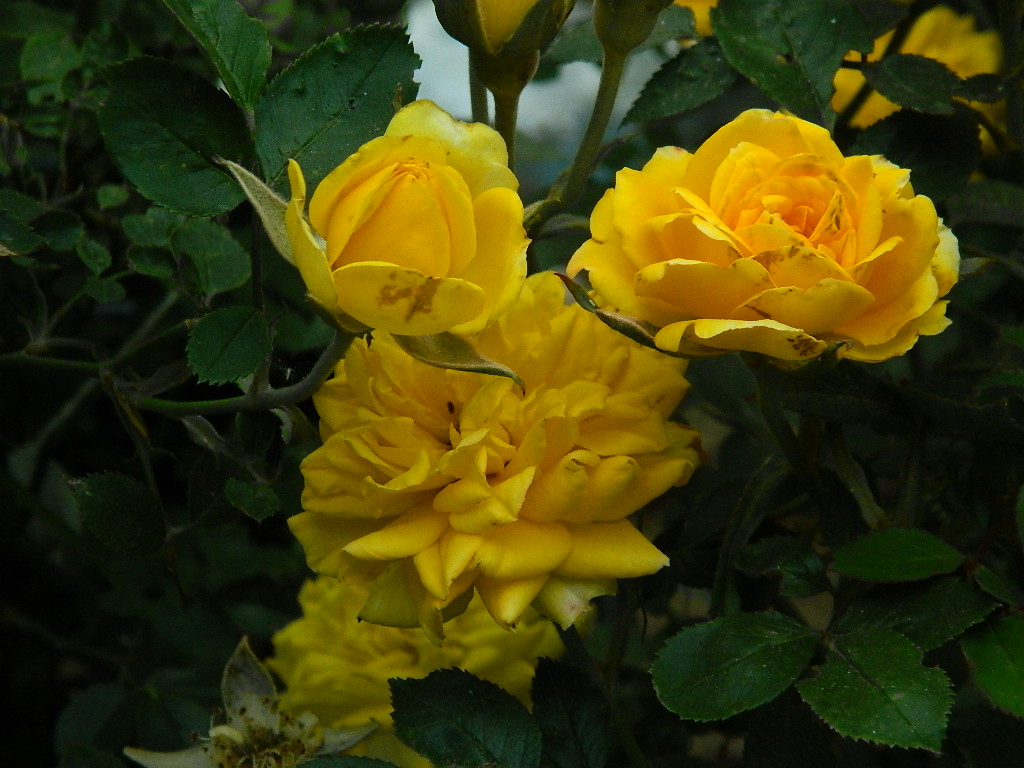I did bring 1-72-1Hugonis with me and it’s doing the best it can trapped in a seven gallon can. I don’t have any pollen left from it, or any of its crosses, but it threw an odd bloom about two weeks ago, which I collected and used. Sunshine (I no longer grow it, but it may be available through Burlington Roses as I provided it to Sequoia and Burling took it with her when the nursery closed) sets many seeds which often don’t germinate. I realize the climates and conditions are different, but mildew seemed to follow its pollen in the few crosses I made with it. I love the rose but chose not to bring the 3’ standard of it with me, leaving it with a friend in Santa Barbara (I have cutting rights!).
There is a found rose out here which may be suitable for you. Schmidt’s Smooth Yellow is a definite Agalia offspring discovered in an old garden in San Rafael by Jackie Schmidt. It’s thornless and flowers constantly. It sets many self hips which I have not germinated. My first impression upon seeing Schmidt’s Smooth Yellow was it was definitely out of Aglaia. The plant architecture, foliage, textures, petal substance, hips…everything, are highly reminiscent of Leonie Lamesch, only in pale yellow. I’m convinced it is the old Eugenie Lamesch, which was commercially available in the US up until WWII, but disappeared after the war. There is another yellow poly-like found rose, Belmont Yellow, which resembled it from flower photos, but has turned out to be more of a Wichurana-type, ever blooming rambler-like plant.
Malcolm Manners, at Florida Southern College, was provided material from Schmidt’s Smooth Yellow, Belmont Yellow and De Candolle, the only Eugenie Lamesch offspring available in the US, for summer students there to test them against each other to see what could be determined. That was three years ago. What has been determined is both Belmont Yellow and Schmidt’s Smooth Yellow carry the same strain of PNRSV, indicating they may well have been commercially budded by the same source at one point. The students who ran the tests (grad students) are still working up their results to be published, and Malcolm isn’t positive (he isn’t their professor) that De Candolle was tested against Schmidt’s, but, supposedly they’re getting close. As Malcolm stated, “how many grad students does it take to change a light bulb? Only one, but it can take him 13 years to accomplish it!” Perhaps it’s a good point to also share that Sunshine is definitely infected with RMV. The paisley patterns appear in the foliage regularly. It doesn’t seem to inhibit it out here, but in a more severe climate, and/or if that is important to you, be fore warned.
Now, the good news. A dear friend in Santa Barbara has very well established plants of Schmidt’s, Belmont Yellow and Sunshine (my old patio standard) 'Sunshine ' Rose Photo . She’s about an hour south of me, but with planning and time, cuttings can be obtained. I left Schmidt’s with her as the Aglaia petal substance is just too fragile for the UV intensity here and the UV and heat intensity of the old climate. Like Leonie’s, the flowers fried very quickly unless grown in fairly dense shade. I expected Sunshine to also fry and to have mildew issues this close to the ocean, and she’s on a sunny, warm western facing hillside with tall oaks, in an 1898 California bungalow that began life as an orange grove office and communal cafeteria, her family has owned since the mid sixties.
If you don’t have to have a diploid, Jim’s First Impression is a very nice yellow triploid floribunda and has yielded some pretty interesting results for me. There are also Ralph Moore’s triploid yellow minis, Golden Angel and Golden Horizon, both of which I grow and use. Golden Horizon
